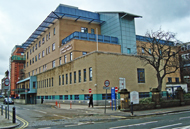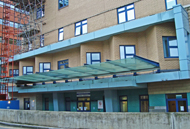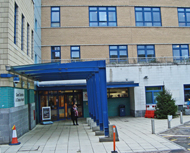Obstetrics. Later, also gynaecology
The new Queen Charlotte's Maternity Hospital, located on a 6-acre site in Ravenscourt Park, Hammersmith, was intended to be the largest maternity hospital in the British Empire, almost double the size of its current Marylebone Road site. It would have 358 beds - 200 in public wards, 80 for private patients ('middle-class patients of small means') and 48 prenatal; a separate isolation block would contain 30 beds and a nursery with 30 cots.
The main Hospital buildings were to be located at the southwest of the site, facing almost due south. The 4-storey ward blocks would comprise two 100-bed units and 48 prenatal beds. An annexe at the rear would contain the staff dining rooms. A 5-storey block for private patients was to be built on the eastern side, with an isolation block for women suffering from puerperal fever on the northeastern side. The administration block, Nurses' Training College and Nurses' Home (with 180 single bedrooms) were to be 5 storeys high and would front Goldhawk Road, as would the Out-Patients Department block. All these buildings were to be grouped around a central lawn.
Despite having raised only £140,000 of the £500,000 needed for the rebuild, work began in August 1929 on the first part of the Hospital, the isolation block. While the building work was going on, several large empty houses on the site were converted for Hospital use. 'Longthorpe Lodge' had opened in April 1930 as the Antenatal Department and District Midwives Home (it also contained some accommodation for nurses). 'Invermead' at 341 Goldhawk Road opened in July 1930 as an auxiliary hospital with 20 beds, and 'Oakbrook' at 339 Goldhawk Road became the Nurses' Home for 22 nurses and domestic staff.
The foundation stone for the isolation block had been laid in November 1929 by Princess Marie Louise but the opening ceremony was performed by Princess Mary, Countess of Harewood, in July 1931 (although the first patients had been admitted in September 1930).
By 1930 the Hospital's maternal mortality rate had increased to a rate of 4.40 per 1000 live births - but the new isolation block enabled rapid treatment of mothers with puerperal fever. 84%, who might otherwise have died, were discharged cured. Those who did not recover were too far advanced on admission for there to be any hope of their fighting the infection.
Each floor of the isolation block contained a sterilizer for crockery and eating utensils used by the patients. Milk for the infants and special dietary foods for the patients were kept in refrigerators. On each floor also was a room for sterilizing the mackintosh (rubber) bed sheets - an innovation in hospital planning. The sluice rooms for dealing with bed pans had a sink fitted with a jet and a douche over which the bed pan could be inverted. The pans were then sterilized in a large steam sterilizer and transferred to a chromium-plated rack. Each bed pan was numbered to correspond with a bed. Each sluice room was fitted with a specimen cupboard let into the wall. The cupboard was closed by a hermetically sealed door, but its back communicated directly with the open air through a sheet of gauze. Soiled linen was collected in a bag and placed on an open-air landing at the end of each corridor. The bags were collected via a hand-worked lift and delivered to a trolley which ran on a concrete way to the boiler house. The soiled linen bags were then steam washed, put into a hydro extractor, and finally sent to the laundry having been sterilized and disinfected.The next part of the Hospital to be completed was the 3-storey Bernhard Baron Memorial Research Laboratory, which was built adjacent to the isolation block and opened in 1931. Its main purpose was to study the causes of puerperal fever. The Laboratory and the isolation block had cost £146,500 to build. At this time the Hospital had 130 beds - 80 at its Marylebone Road site, 20 in 'Invermead' and 30 in the isolation block.
In 1936 work began on the first ward block - the western wing - which had been modified in size and increased to contain 112 beds, including 14 private patient rooms and some nursing accommodation. 'Invermead' the auxillary hospital, was demolished.
By this time the site had been paid for, but the ward block would cost £98,000 and the Nurses' Home and students hostel (also to be built in 1936) £50,000. Some £144,500 still needed to be found for the rest of the buildings, including the remaining ward blocks, the private patients wing and the Out-Patients Department. The Queen Charlotte's Ball, held every May, provided a fund-raising opportunity for the Hospital.
In 1936 a German drug, Prontosil, a sulphanilamide, became available for the treatment of puerperal fever caused by haemolytic Streptococcus. Use of the drug reduced the mortality rate in the isolation block to 5.1% in 1937, and to 3.2% in 1938.
Throughout the 1930s the Hospital continued to operate on two sites. It had 184 public beds, 24 antenatal beds and 32 private patient beds, as well as a theatre suite, lecture room and X-ray Department.
In 1938 the Human Milk Bureau was established, dispatching human milk from six London termini to all over the country. Building work continued on the second phase of the main ward block, which had almost been completed.
The Nurses' Home for 130 staff, which also contained the main kitchens, dining room and stores, as well as the Training School, had been half built at the outbreak of war in 1939, but it was decided to continue the building work until the carcass had been completed, as the financial outlay to preserve the steelwork and other matters would be too great.
The outbreak of war caused great anxiety as almost all the honorary medical staff were called away for other duties but, with the help of members of the consultative staff, the Hospital was able to continue its services unimpaired. Demand for beds was high, and preference was given to wives of servicemen.
The isolation block was closed in 1939 and taken over by the Hammersmith Borough Council to use as a First Aid post and decontamination centre (gas attacks were still expected because of mustard gas being used in WW1). The Nurses' Home in 'Oakbrook' was closed (the building later became the Hospital's administration block). The Bernhard Baron Memorial Research Laboratory was also closed for the duration of the war and its staff redeployed in different parts of the country in the Emergency Public Health Laboratory Service organised by the Medical Research Council.
The Marylebone Road site closed in 1940 and all services moved to the Goldhawk Road site when the first section of the ward block was finally completed.
In January 1944 the Hospital received £30,000 from the Bernhard Baron Trustees for the Nurses' Home project (and another £20,000 in 1947 so that it could be completed).
In 1945 the whole of the main ward blocks opened with 135 beds and 130 cots. The isolation block, no longer needed because of drug treatment for puerperal fever, was converted into use as an Out-Patients Department for ante- and postnatal clinics. Now that the war was over, negotiations began with the Chelsea Hospital for Women with a view to forming a combined postgraduate training school for obstetrics and gynaecology.
The Research Laboratory reopened in 1947. In 1948 the Hospital joined the NHS, merging with the Chelsea Hospital for Women and becoming a postgraduate teaching hospital. Both hospitals were placed in the separate Regional Hospital Board for London Teaching Hospitals, under the control of the newly created Queen Charlotte's and Chelsea Hospitals Management Committee.
The Nurses' Home was finally completed in May 1950, which freed up space for 40 more beds in the main block, but the shortage of nurses meant that only 25 of these could open. A Porter's Lodge was built, thus securing the Hospital by a single entrance. In 1950 the Hospital had 156 beds and 142 cots and, by 1951, 165 beds and 151 cots.
By 1971 the population of London was decreasing and, nationally, the birth rate was falling. Better obstetric care and a healthier population meant fewer complications affecting mothers and babies. The reduced length of stay in hospital, originally introduced because of bed shortages, was increasingly favoured by the mothers. The future of the Hospital, which by then had 140 beds, became uncertain. It was felt the Region would have too many maternity beds and proposals were made to either close the entire Hospital, for it to become the Maternity Unit of the new (yet-to-built) Charing Cross Hospital, or to move the academic departments to the Hammersmith Hospital while clinical work continued at the Goldhawk Road site.
In 1974, following reorganisation of the NHS, the Hospital became part of the Postgraduate Teaching Regional Hospital Authority and was designated a District Health Authority in its own right. Queen Charlotte's Maternity Hospital (with 157 beds) and the Chelsea Hospital for Women (with 126 beds) were united under the title of 'The Queen Charlotte's Hospital for Women'. By 1976, however, plans were being made to relocate all services to the Hammersmith Hospital site in Du Cane Road. With this in mind, in 1982, following yet another NHS reorganisation, the Hospital became linked with the Hammersmith Hospital under one Regional Health Authority.
In 1988, following long negotiations with the Chelsea Hospital for Women, the Hospitals merged onto one site and alll functions transferred to Queen Charlotte's Hospital. It was renamed Queen Charlotte's and Chelsea Hospital; it had 141 beds.
In 1994, when it had 120 beds, the Queen Charlotte's and Chelsea Hospital formed the Hammersmith Hospitals NHS Trust with the Hammersmith Hospital.
At the end of 2000 the Hospital moved to new premises built on the Hammersmith Hospital campus.
The original plan of a 358-bedded hospital was never realised. The private patients block was never built, neither was the Out-Patients Department, intended to be on the site of Oakbrook.
The site was bought by Crest Nicholson. The buildings have been demolished and the site has been entirely redeveloped. It now contains Vitae, a complex of apartment blocks.
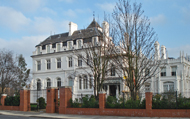
At the north end of the site the Grade II listed Oakbrook remains.
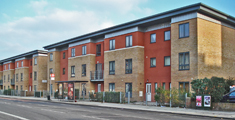
The site now contains a block-long row of low rise apartments - Vitae.
In May 1930 No. 240 Ladbroke Grove was leased for the Antenatal Department of the North Kensington branch, to replace No. 176 Ladbroke Grove, a building which was inadequate.
In 1934 pupil midwives received training in the administration of chloroform capsules, and this enabled patients being delivered at home to receive anesthesia during childbirth.
The Hospital also maintained Midwives Homes in Kilburn (40 Princess Road) and Hammersmith (Longthorpe, 351 Goldhawk Road). The main Hospital address was 349 Goldhawk Road, the administration block and Research Laboratory at 339 Goldhawk Road and the ante- and postnatal clinics at 341 Goldhawk Road.
Home deliveries became less popular as the 20th century progressed. In 1908 some 2169 babies had been delivered at home. By 1948 this number had reduced to 975. In 1953 there were only 441 home deliveries, and the domicilary midwifery service became unviable.
(Author unstated) 1927 Queen Charlotte's Hospital. Plans for extension. British Medical Journal 1 (3461), 861.
(Author unstated) 1932 How to save our mothers - appeal for £150,000. British Journal of Nursing Supplement. The Midwife (July), 196.
(Author unstated) 1939 Bicentenary of Queen Charlotte's. British Medical Journal 1 (4093), 861.
(Author unstated) 1940 Queen Charlotte's Maternity Hospital. British Journal of Nursing Supplement. The Midwife (May), 1251.
(Author unstated) 1971 Future of Queen Charlotte's Hospital. British Medical Journal 1 (5749), 567-568.
Dewhurst J 1989 Queen Charlotte's - The Story of a Hospital. Privately published.
Donnison JE 1971 Note on the foundation of Queen Charlotte's Hospital. Medical History 15, 398-400.
Ryan T 1885 The History of Queen Charlotte's Lying-In Hospital. Publisher unstated.
http://freepages.geneaology.rootsweb.ancestry.com
http://hansard.millbanksystems.com (15th March 1971)
http://hansard.millbanksystems.com (19th March 1971)
www.aim25.ac.uk
www.artcontact.co.uk
www.flickr.com
www.imperial.nhs.uk
www.institutions.org.uk
www.ncbi.nlm.nih.gov
www.pastscape.org.uk
www.victorianlondon.org
Return to home page
